Air Cooled VCSEL Applications with Rogers Micro-Channel-Coolers (MCC)

“When air-cooled heat sinks cannot cope with too high power densities, liquid-cooled cold plates are the heat transfer solution of choice.” [1]
Reading this statement got me thinking: How would ROGERS’ Micro-Channel-Coolers (MCCs) perform in air cooling applications? Rogers'MCCs have only been used for liquid cooling; however, customers´ heat management challenges in new VCSEL (vertical-cavity surface-emitting laser) applications are reaching new levels, and several active-cooled approaches are being tested. For our partners, the challenge for moving to liquid cooling is that it is both risky [2], and the cost and maintenance increase while passive/standard air-cooling options might not be able to solve the thermal problem. For that reason, we started testing and evaluating Rogers'MCCs with compressed air as a coolant. As a result, different micro-channel designs have been benchmarked with standard macro-channel heat sinks.
Theses to test:
Rogers'MCCs can achieve a better cooling performance vs. off-the-shelf Macro-Channel cold plates at lower flow rates.
Qua 50 will be the best performing Rogers’ standard MCC structure.
Simulation and conditions
We performed simulations with SolidWorks Flow Simulation 2020 based on the conditions mentioned below, shown in fig. 1. For all thermal CFD simulations of the cooling structure, we applied the inlet and outlet configuration depicted in fig. 2. Unless stated otherwise, we kept the cooler area, as well as the chip position, constant for all simulations and comparisons. The cooler is comprised of four individually structured copper layers with a thickness of 200 µm each. The first layer acts as cover. The following two copper layers form the cooling channel. The last copper layer forms the backside cover, see fig. 3.
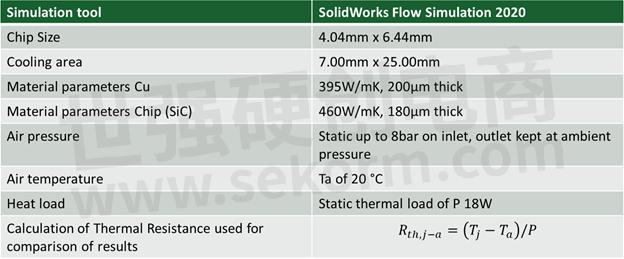
Fig 1: Boundary conditions for the test
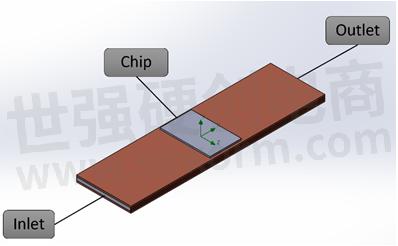
Fig. 2: Configuration of an inlet, outlet and a chip on cooling structure
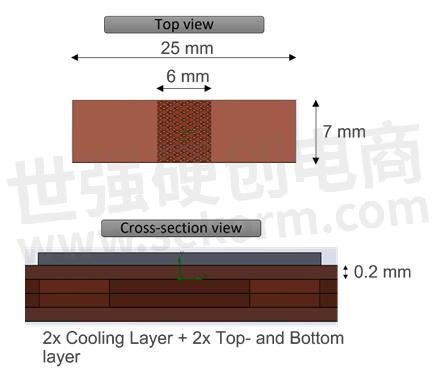
Fig. 3: Top and cross-section view of a cooling structure
To run the simulations, we used three different cooling structures. Type 1 corresponds to Rogers’ Qua 50 structure and type 2 corresponds to a Qua 100 shown in fig. 4. It should be noted that Qua 50 uses 50% smaller geometries than Qua 100. Compared to these, we used a Hex 50 (type 3) and two standard lamellar coolers with five channels in the size 0.5mm x 0.4mm (type 4) and three channels in the size 1.00mm x 0.4mm (type 5), all shown in fig. 5.

Fig. 4: Left to right: Schematic fluid flow through a cooling structure; Detail of a Hex 100 and Qua 100 inner cooling structure
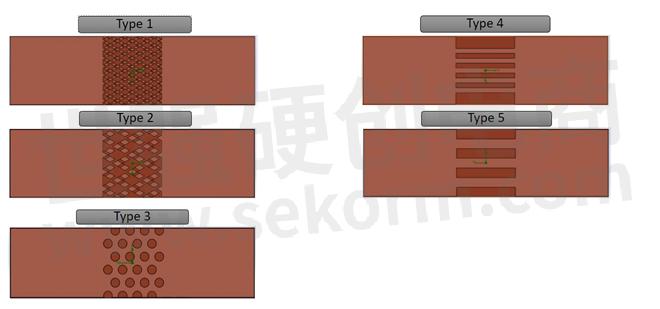
Fig. 5: Top view on cooling structures, five different types are shown
Results and Discussion
Fig. 6 shows the flow velocity distribution of type 1 and type 4. We can clearly seen that in the channels of type 4, laminar flow is dominate while the cooling structure of type 1 supports a turbulent flow. This, in combination with a larger effective cooling area of type 1, leads to a higher heat transfer coefficient at the same flow rate, depicted in fig. 7. Here, the cooling structure type 1 has the highest heat transfer coefficient at the same flow rate. The smaller cooling structure of type 1, 2 and 3 also leads to a faster increase of the pressure on the inlet compared to type 4 and 5, shown in fig. 8.
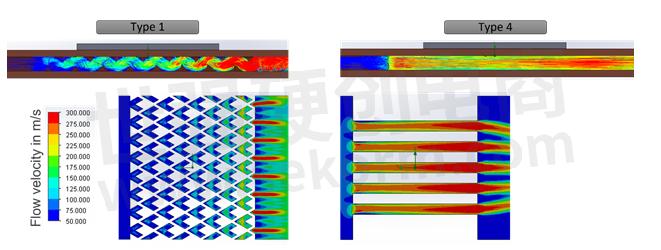
Fig. 6: Top view on cooling structures, five different types are shown
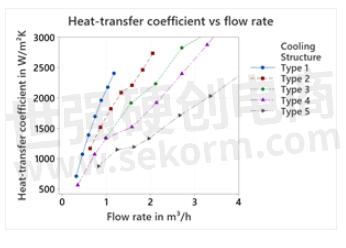
Fig. 7: Heat transfer coefficient vs. flow rate
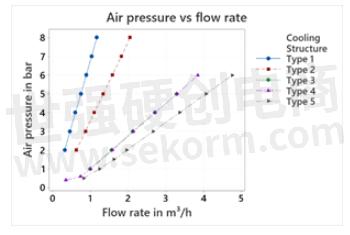
Fig. 8: Air pressure vs. flow rate
Improved performance in comparison with competition comes from a higher specific surface area, as well as a maintained turbulent flow. For certain areas of application, air cooling can be superior to water cooling due to its simple availability, despite the worse thermal performance of air itself. Likewise, liquids are not often used in electronics due to the risk of leaks. Assuming, compressed air up to 90psi is relatively common and available at manufacturing locations, Rogers’ Type 1 micro-channel structure realizes about 50% lower operating costs versus cooler type 4 and 5. Calculating with 7.000 working hours per year times 0,02€ m³/h this accounts for 140€/year less per unit.
Our next steps are to confirm simulation results through tests carried out on our test bench and in customer applications. Another target is to also optimize cooling structures for air cooling use cases to improve performance and cost.
- +1 Like
- Add to Favorites
Recommend
- Kinghelm‘s Micro-B Female USB Connector KH-MICRO-SMT.J7.2-5P with Current Rating of 1A Max
- Kinghelm‘s Micro-B Connector KH-MICRO-SMT.ZJ-5P Has a High Durability and High Transmission Rate for Electronic Devices
- Kinghelm‘s Micro-B Female Connector KH-MICRO-SMT.LF-5P has a Mounting Style of SMD and Number of Contacts of 5P
- Kinghelm Micro-B Female USB Connector KH-MICRO-DIP-2P with the Voltage Rating of 30V DC and Current Rating of 1.5A/Contact Terminal
- Kinghelm‘s Micro-B Connector KH-MICRO5P-JN Commonly Used for USB Interfaces, Including the USB 2.0 and USB 3.0 Standards
- Kinghelm Micro-B Receptacle Sunk Board USB Connector KH-MICRO1.17CB-5PJ with Contact Resistance of 50 Milliohms MAX
- Kinghelm‘s Micro-B Female USB Connector KH-MICRO-SMT.MK-5P Conforms to the USB 2.0 Standard for Space-limited Devices
- Rogers Announces Acquisition of Silicone Engineering
This document is provided by Sekorm Platform for VIP exclusive service. The copyright is owned by Sekorm. Without authorization, any medias, websites or individual are not allowed to reprint. When authorizing the reprint, the link of www.sekorm.com must be indicated.






























































































































































































































































































































































































































































































































































































































































































































































































































































































